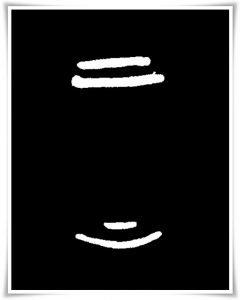
1. Meaning:
above, up, elder, ascend, summit, surface, on, superiority, etc.
2. Readings:
- Kunyomi (訓読み): あ.がり, -あ.がり, あ.がる, -あ.がる, あ.げる, -あ.げる, うえ, -うえ, うわ-, かみ, のぼ.す, のぼ.せる, のぼ.り, のぼ.る, よ.す
- Onyomi (音読み): シャン, ショウ, ジョウ
- Japanese names: あおい, あげ, い, か, かき, かず, かん, こう, のぼり, ほつ
- Chinese reading: shǎng, shàng
3. Etymology
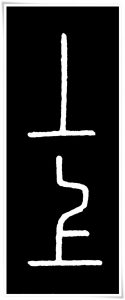
上 belongs to the 指事文字 (しじもじ, shijimoji, i.e. set of characters expressing simple abstract concepts). The original idea expressed by the oracle bone script (甲骨文, こうこつぶん, kōkotsubun) forms, as well as some of the kinbun (金文, きんぶん, kinbun, i.e. “text on metal”) forms, which preceded later forms of tenbun (篆文, てんぶん, i.e. “seal script text”), suggests that 上 was a conception of an object placed above a curved human palm (Figure 1).
According to the 說文解字 (pinyin: shūowén jiězì, i.e. “Explaining Simple (Characters) and Analyzing Compound Characters”) from the 2nd century C.E., compiled by a philologist of the Han dynasty (漢朝, pinyin: Hàn Cháo, 206 B.C. – 220 C.E.), 許慎 (Xǔ Shèn, ca. 58 C.E. – ca. 147 C.E.), the character 上 originally meant “the higher part (or place)”, and it was represented by two horizontal lines, as shown in Figure 1. In later stages its meaning was broadened to the general idea of “above”, or “on top of”, etc.
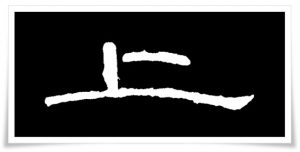
Later seal script forms of the character 上 were derived from those of oracle bone script and kinbun. Its meaning was represented by a horizontal line at the base of a character with the top part indicating an object placed above (Figure 2).
The character 上 was, and still is, used to represent a higher social status. The kanji 下 (した, shita, i.e. “below”) is based on a similar concept, (originally) being the exact opposite of 上 (read more here).
4. Selected historical forms of 上 .
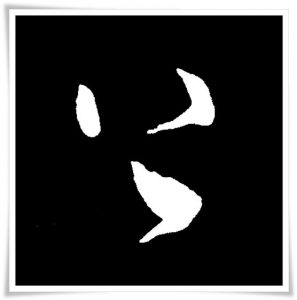
Figure 1. Oracle bone script (甲骨文, こうこつぶん, kōkotsubun) forms of 上, Shang dynasty (商朝, 1600 – 1046 B.C.).
Figure 2. Two forms of the character 上 found in the book 說文解字 (pinyin: shūowén jiězì), small seal script (小篆, しょうてん, shōten).
Figure 3. Clerical script (隷書, れいしょ, reisho) form of the character 上, ink rubbing from the stele “Stone Gate Eulogy for Yang Menweng” (楊孟文石門頌, pinyin: Yáng Mèngwén shímén sòng), 148 C.E. The text is often used for the study of the clerical script of the late Han dynasty (漢朝, pinyin: Hàn Cháo, 206 B.C. – 220 C.E.)
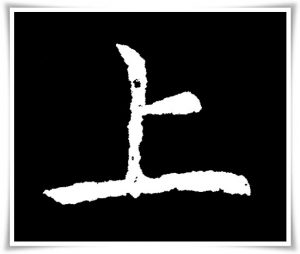
Figure 4. Ink rubbing of the character 上 taken from the calligraphy entitled Gushi Sitie (古詩四帖, pinyin: gǔ shī sìtiē) by 張旭 (Zhāng Xù, unfortunately, the exact dates of his birth and death are unknown) of the Tang dynasty (唐朝, pinyin: Táng Cháo, 618 – 907 C.E.) in cursive script (草書, そうしょ, sōsho).
Figure 5. Ink rubbing of the character 上 in standard script (楷書, かいしょ, kaisho) taken from the stele in the Mausoleum of Confucius (孔子廟堂碑, pinyin: Kǒngzǐ miàotáng bēi), 7th century C.E.
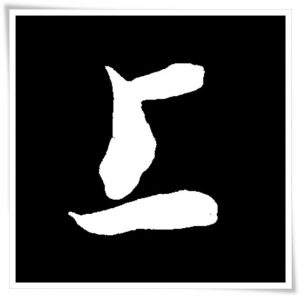
Figure 6. Ink rubbing of the character 上 in semi-cursive script (行書, ぎょうしょ, gyōsho) from the calligraphy 千字文寶墨軒 (Chinese: Qiānzìwén bǎomò xuān) by 智永 (pinyin: Zhì Yǒng, unfortunately his exact dates of birth and death are unknown) of the Chen dynasty (陳朝, pinyin: Chén Cháo, 557 – 589 C.E.).
5. Useful phrases
- 上品 (じょうひん, jōhin) – refined, elegant
- 以上 (いじょう, ijō) – not less than, …and more,
- 上部 (かぶ, kabu) – upper part/li>
- 上級 (じょうきゅう, jōkyū) – advanced level
- 上達 (じょうたつ, jōtatsu) – improvement
